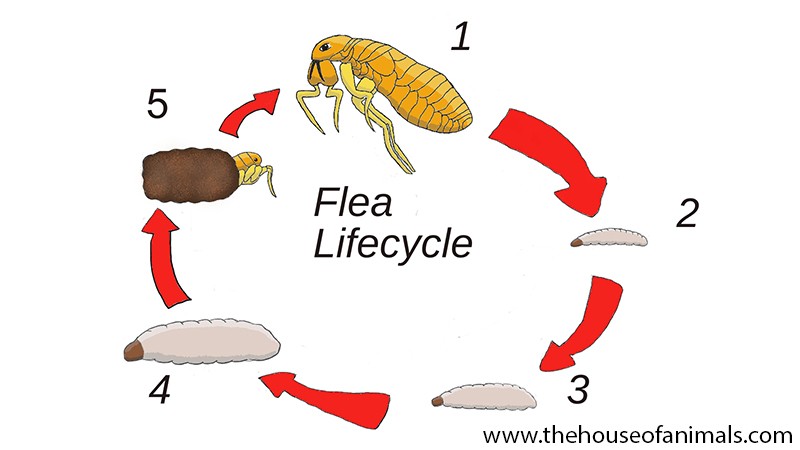We love our pets. They live in our homes, share our bed, cuddle with us on the sofa, but fleas and worms love your pet too! It’s so important to keep on top of flea and worming to keep your pet as healthy as possible and to prevent an infestation.
Flea treating
This needs to be applied following the manufacturer’s guidelines. Although more expensive, you do need the ones your vet sells as pet shop ones aren’t effective. There have also been a few reports on over the counter flea treatments hurting pets, so it really isn’t worth risking your pet’s health. It’s always best to prevent the fleas as it’s cheaper and easier than dealing with an infestation, not to mention how uncomfortable they are for your pet too. Also, the fleas will bite you too, so it’s in everyone’s best interest to keep these little bloodsuckers away!
The “spot on” treatments from your vet is a liquid product supplied in a small tube. You will need to part the hair on the back of the neck and apply the liquid to your pet. It will distribute on the lipid layer of the skin and hair follicles, and will also absorb through the skin and to the bloodstream, where it will target any parasites and kill them.
If your pet runs a mile at the sight of the flea medicine, there are also chewable tablets which many animals find palatable.
There are also flea collars, many of which last a good few months – just make sure you mark on your calendar when they need replacing to remain effective.
How to deal with a flea infestation
You may not see fleas unless you have a severe infestation, but fleas will bite you as well as your pet. To check for fleas, groom your pet with a comb and put the hair on a white sheet of paper. Put a tiny amount of water on the hair and move it around – if you see red streaks, this is flea droppings. If you do find fleas, don’t panic as you can get rid of them.
There are many flea sprays that you can use – make sure you read the manufacturers instructions as to how to use them and remove all pets before spraying.
Your dog or cat can pick up fleas from fleas in the environment, or from other animals that have them. Fleas don’t only hop on your pet to feed, but can also live in your furnishings which is why if you have a flea infestation, you need to treat your whole house and not just your pet.
There are several stages in the fleas life cycle, which is why they can be difficult to get rid of;

- The adults feed on any warm-blooded animal (including you!) and will lay eggs on your pet, One adult female flea can lay 40 – 50 eggs per day, and can lay several hundred over her lifespan. The eggs fall onto your furnishings as your pet walks around.
- The eggs develop into first-stage larvae wherever they have landed. As they are so small, they are able to develop anywhere, including tiny cracks in the floor and in the carpet.
- It then moults into second stage larvae, which live within the carpet fibres and can even survive outside. They feed on organic matter, such as skin, as well as the faeces of the adult flea, which is rich in blood.
- It then moults to third-stage larvae.
- Two weeks later, it will form a cocoon and hatch into an adult flea. The pupae are highly resilient and can wait for the right environmental factors before hatching into an adult flea. When they detect vibrations, heat and exhaled carbon dioxide (which indicates a host is nearby), they will emerge and jump onto the host and the cycle starts again.
This is why only giving your pet a flea bath, or putting a flea collar on them will not work. You will need to wash all bedding on a hot wash to kill any eggs (including your bedding, if your pet shares your bed), and give everywhere a good vacuum. Don’t forget to empty the vacuum bag right away as this will be full of fleas and their eggs.
Steam cleaning will also help, however, this alone will not kill the fleas. You will need to spray everywhere in your home with the flea spray (In the past, I have used Indorex with good results).
Fleas can go on laminate or hardwood flooring, so sweep up any loose hair before you spray. Wash any soft toys your dog has with a hot wash too. Be really careful if you keep reptiles or aquatic animals as the spray can kill them. Cover their tanks with a blanket, spray the product and open all windows and doors – also make sure your other pets are out the way too as the fumes are strong.
Flea allergies
Some animals are allergic to flea bites and your pet only needs to get a few bites to have a reaction. Whilst most pets who are bitten by a flea will be itchy, animals with a flea allergy have hypersensitivity to flea saliva, meaning they will scratch and chew their skin until it is red and raw.
Signs of a flea allergy is hair loss/thinning, red bumps or spots and itching around the base of the tail/neck/inner thighs. Cats can get something called miliary dermatitis which are indicated by small, crusty bumps and this can appear all over the body. The animal can gnaw, lick and rub the affected area, which can make it worse and lead to infections, which will need treating with antibiotics.
Treating for worms
There are several types of worms that can affect your dog or cat, so it’s important to make sure the treatment you are using is effective against all the different types. Unfortunately, lungworm is becoming more and more common and there have been lots of outbreaks recently so you need to make sure the treatment you are using is effective against lungworm.
Other types of worms your dog can become infected with are heartworm, skin worm and intestinal worms, such as whipworm, hookworm and tapeworm. All of which are harmful to your pet and some are even fatal.
Cats can also get heart worm, as well as round worms, hookworm and tapeworm so they need covering against all of these. Again, it’s always better to prevent these parasites which is why worming and flea treating should be part of your lifestyle. You can get a spot-on treatment that will cover most the parasites, so talk to your vet who can advise you.
Well, I feel pretty itchy after writing this, but it needed to be said! Set a reminder on your phone or write in your calendar when your pet is next due his or her parasite treatment and talk to your vet to discuss the most effective treatments. Prevention is always best!

